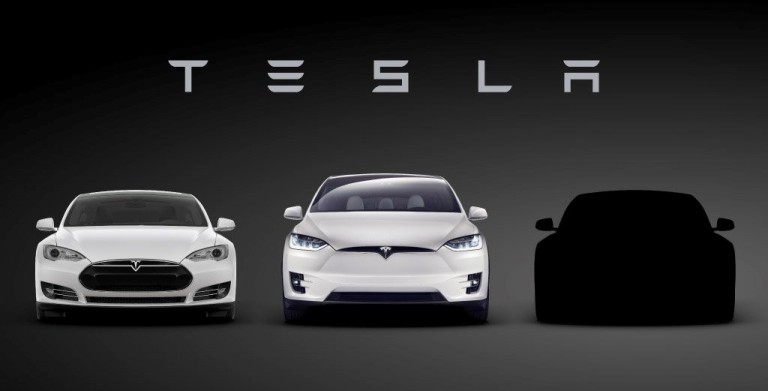By Griffin Schnitzer '18
Tonight, Tesl a Motors will unveil its fourth vehicle since the company’s inception, the Model 3. Tesla marked March 31st as the official date that this long awaited automobile will open to reservations, ending months – even years – of speculation as to what this next iteration of the electric vehicle will be. This car, according to Tesla’s CEO Elon Musk, is all about “higher volume and lower cost,” completing the three-step plan that he has led the company along (Jennings). This business model began with the “expensive car, low volume” Roadster in 2008, followed by the “medium price, medium volume” Model S and Model X (2012 and 2015, respectively), and now will realize its ultimate goal of appealing to the mass-market consumer with this release (Hoffman). As a culmination of years of work done by the electric vehicle company, this product release has major implications for both the future of the company and the larger auto industry.
a Motors will unveil its fourth vehicle since the company’s inception, the Model 3. Tesla marked March 31st as the official date that this long awaited automobile will open to reservations, ending months – even years – of speculation as to what this next iteration of the electric vehicle will be. This car, according to Tesla’s CEO Elon Musk, is all about “higher volume and lower cost,” completing the three-step plan that he has led the company along (Jennings). This business model began with the “expensive car, low volume” Roadster in 2008, followed by the “medium price, medium volume” Model S and Model X (2012 and 2015, respectively), and now will realize its ultimate goal of appealing to the mass-market consumer with this release (Hoffman). As a culmination of years of work done by the electric vehicle company, this product release has major implications for both the future of the company and the larger auto industry.
Beginning with the impact this release has on Tesla Motors, a review of the company’s financials is in order. Thus far, the business has posted just one profitable quarter in its history -- the second quarter of 2013 -- and since then has posted net losses of increasing size, as money is funneled into R&D and into increasing the production rates of new products. As this has gone on, Tesla stock has fluctuated wildly, rising from $40 in April 2013, to a high of $282 in July 2015, to the current price of $228 (TSLA). Since the latest earnings report, however, the stock has steadily risen with expectations for future profitability and for a successful introduction of the Model 3.
The future of the company resultantly depends on a successful rollout of this vehicle. More importantly, however, is the impact that this release will have on the larger auto industry. If Tesla is able to climb into profitability through the sale of a mass-market electric vehicle, it will signify to other car manufacturers that there exists potential to make money through selling electric vehicles. Right now, electric vehicles in America comprise just 0.66% of all cars sold (Cobb). However, a successful release of the Model 3 and ensuing profitability of Tesla Motors could lead to a jump in that number. Just this week, the Director of Battery Electric Vehicles at Audi, in speaking of the fact that most electric vehicles “are slower … have a much lower range … and in compensation they are more expensive” than gas-powered cars, said that Tesla “did everything right” (Hammerschmidt). This demonstration of respect by a traditional auto manufacturer for a producer of electric vehicles shows how such manufacturers may not be too far from a shift in their focus towards EVs.
If the Model 3 is a hit, and Tesla is able to profit from it, then the unveiling of this mass-market car may be the beginning of a larger shift towards implementation of electric vehicles.
Sources:
Cobb, Jeff. "Top Six Plug-in Vehicle Adopting Countries – 2015 - HybridCars.com." HybridCarscom Top Six Plugin Vehicle Adopting Countries 2015 Comments. 2016. Web. 24 Mar. 2016.Hammerschmidt, Cristoph. "Audi Commits to Electromobility – and Bows to Tesla." EETE Automotive. 2016. Web. 24 Mar. 2016.Hoffman, Eli. "Elon Musk: Apple Hires the Engineers We Reject." Seeking Alpha. 9 Oct. 2015. Web. 24 Mar. 2016.Jennings, Richi. "Tesla Model 3 Is Elon Musk's next Huge Bet (with $5.5B More of His Own Cash)." Computerworld. 30 Jan. 2016. Web. 24 Mar. 2016.http://finance.yahoo.com/q?s=TSLAPhoto:http://autoguide.com.vsassets.com/blog/wp-content/uploads/2016/03/tesla-model-3-teaser-image-.jpg